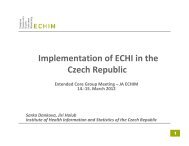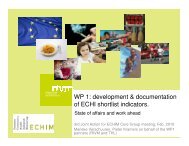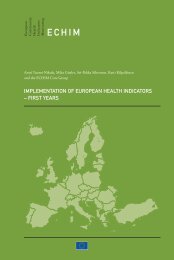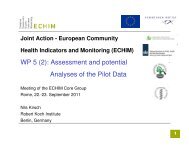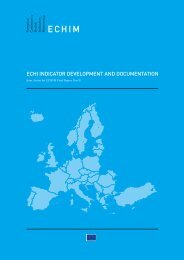INDICATORS
ECHIM Final Report
ECHIM Final Report
You also want an ePaper? Increase the reach of your titles
YUMPU automatically turns print PDFs into web optimized ePapers that Google loves.
Calculation:<br />
1) The number of fetal deaths and deaths in the early neonatal period (up to 6 completed<br />
days after birth) after live birth (weighting 500 grams or more) at or after 22 complete weeks<br />
of gestation in a given year, expressed per 1000 live and stillbirths in the same year.<br />
2) WHO recommendation for international comparisons is 1000 grams or more.<br />
Notes: Perinatal mortality death rate can be sub-divided by timing of death into fetal deaths<br />
and early neonatal deaths (at 0–6 days after live birth).<br />
WHO definition for international comparisons recommended: WHO calculates perinatal<br />
mortality for stillbirths and live births weighting 1000 grams or more, to minimize the<br />
variation in registration criteria (some countries start the registration of fetal deaths from 24<br />
or 28 weeks of gestation).<br />
OECD calculates perinatal mortality as the ratio of deaths of children within one week of<br />
birth (early neonatal deaths) plus fetal deaths of minimum gestation period 28 weeks or<br />
minimum fetal weight of 1000g, expressed per 1000 births.<br />
WHO definitions: Live birth is the complete expulsion or extraction from its mother of<br />
a product of conception, irrespective of the duration of the pregnancy, which, after such<br />
separation, breathes or shows any other evidence of life, such as beating of the heart,<br />
pulsation of the umbilical cord, or definite movement of voluntary muscles, whether or not<br />
the umbilical cord has been cut or the placenta is attached; each product of such a birth<br />
is considered live-born. The number of live births includes all live births during the given<br />
calendar year, irrespective of registration of the date of birth.<br />
Fetal death is death prior to the complete expulsion or extraction from its mother of a<br />
product of conception, irrespective of the duration of pregnancy; the death is indicated by<br />
the fact that after such separation the fetus does not breathe or show any other evidence of<br />
life, such as beating of the heart, pulsation of the umbilical cord, or definite movement of<br />
voluntary muscles.<br />
13. DISEASE-SPECIFIC MORTALITY; EUROSTAT 65 CAUSES – EXAMPLE: SUICIDE<br />
Definition: Deaths caused by suicide (an example of Eurostat, 65 causes of death) per<br />
100 000 inhabitants.<br />
Calculation: Number of deaths (by age group) caused directly by intentional self-harm,<br />
including purposely self-inflicted poisoning or injury, completed suicide (ICD-10 codes<br />
X60–X84) per 100 000 resident population (by age group).<br />
Notes: Accuracy of the data could suffer from inaccurate coding of cause of death. In some<br />
cases it may be difficult to discriminate between accident, self-harm and assault. Thus it<br />
is often meaningful to contemplate the suicide and deaths of undetermined intent figures<br />
together. Some studies have shown that suicides may be under- or misreported and could<br />
affect rates in some countries where undetermined death are relatively high.<br />
14. DRUG-RELATED DEATHS<br />
Definition: Drug-related deaths per 100 000 inhabitants. The definition refers to those<br />
deaths that are caused directly by the consumption of drugs. These deaths occur generally<br />
shortly after the consumption of the substance(s).<br />
91




